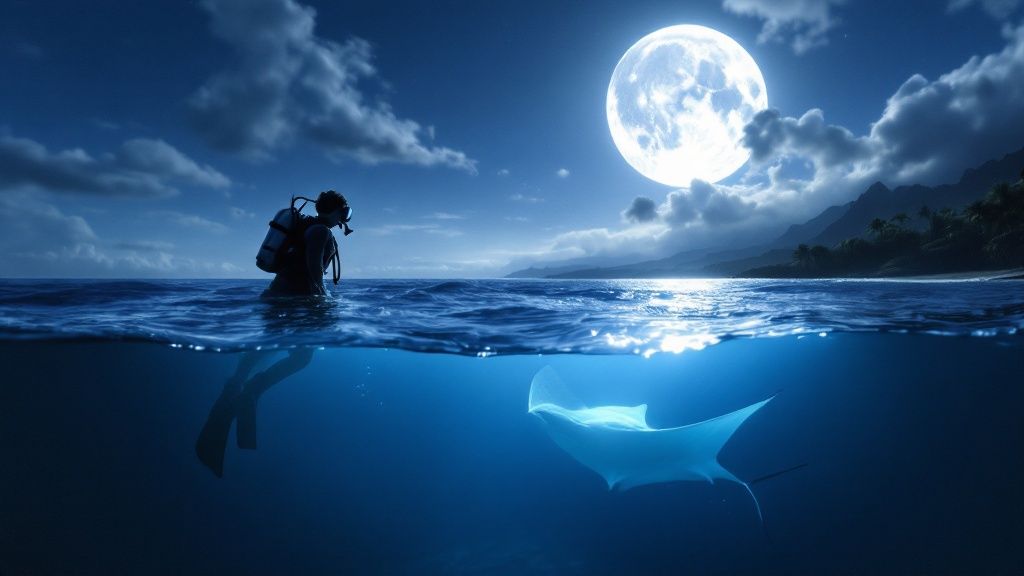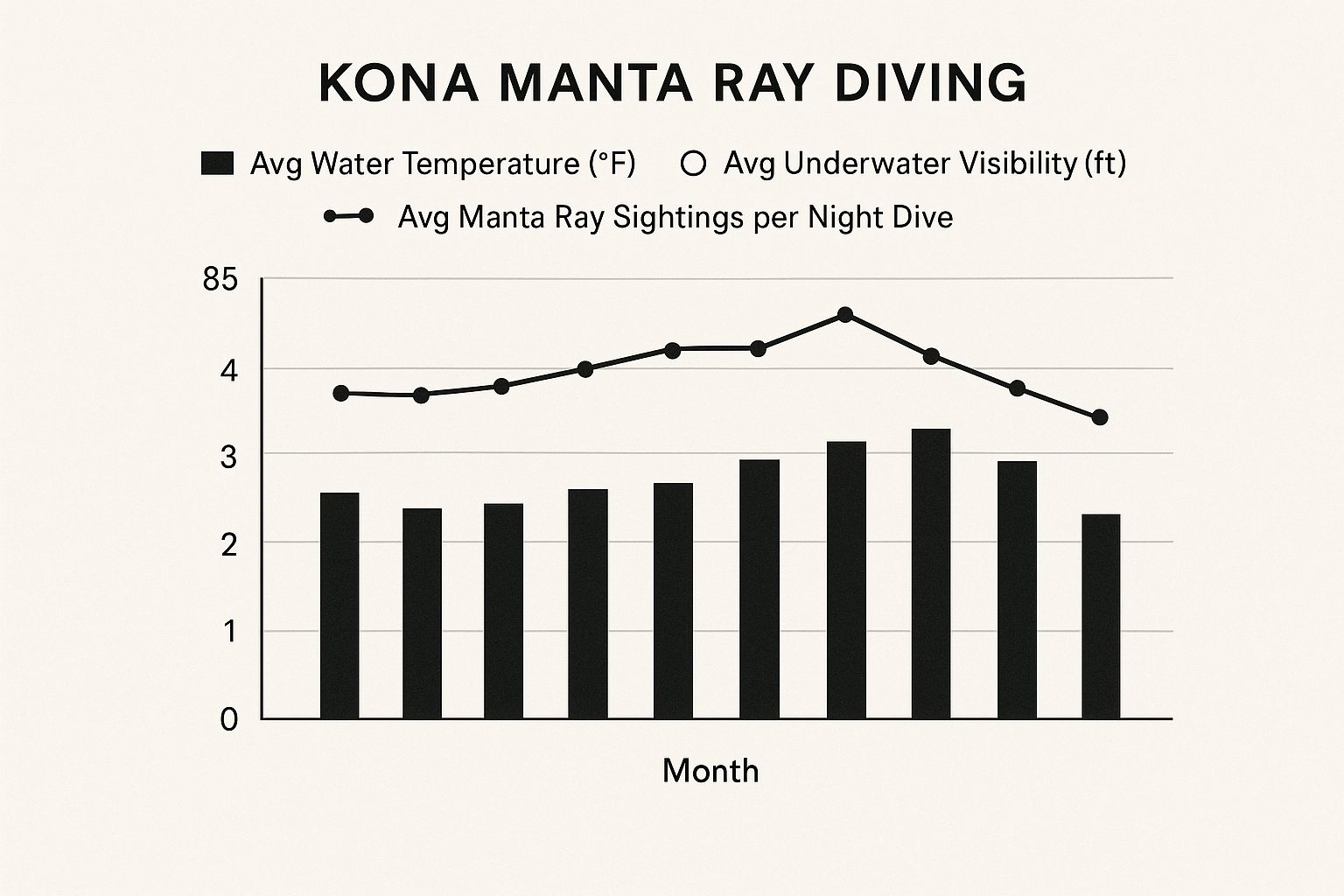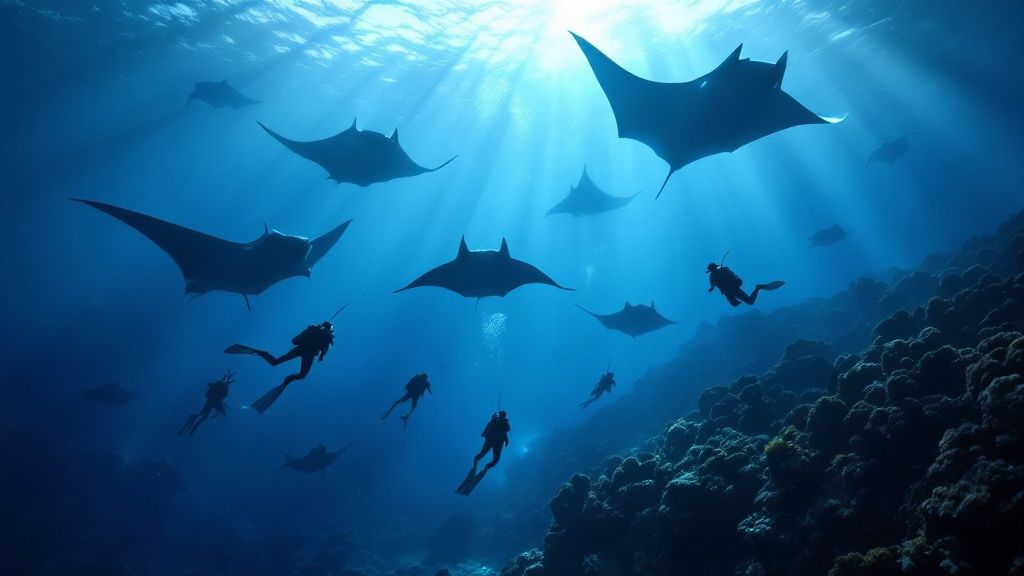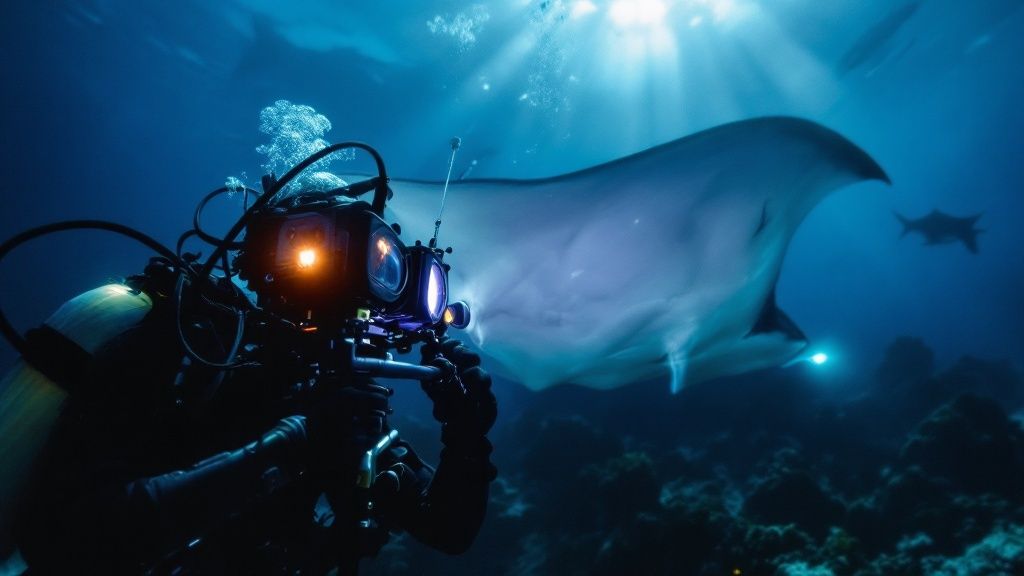The Magic of Manta Ray Dive Kona: Why It's Unforgettable

Imagine floating in the dark depths of the Pacific, the only light coming from the soft glow of dive lights. Suddenly, enormous, graceful shadows appear, their wingspans wider than a car. This is the magic of a manta ray dive in Kona, a truly unique experience. It's not just a dive; it's a profound encounter with some of the ocean's most magnificent inhabitants.
Why Kona Stands Apart
While you can see manta rays in other locations, Kona offers something truly special. The distinctive combination of underwater landscape, nutrient-rich currents, and dedicated conservation work has created a perfect habitat for these gentle giants. These elements lead to incredibly high sighting rates, making an encounter almost guaranteed. The Kona Coast has an astounding 80-90% sighting success rate throughout the year, with approximately 80,000 people participating in guided tours annually as of 2024. Researchers carefully track individual mantas by their unique ventral spot patterns, recording sightings and expanding our knowledge of these incredible creatures. This ongoing monitoring provides essential data on population trends and individual manta ray behavior. For more detailed statistics, visit: Manta Ray Advocates.
The Emotional Impact
The sheer size and graceful nature of manta rays create a powerful emotional connection for many divers. Their slow, elegant movements inspire a sense of peace and wonder, forging a deep bond between human and animal. Many divers describe the experience as life-changing, leaving them with a newfound appreciation for the ocean and its inhabitants. If you're looking to document this incredible experience from above, consider using a drone with camera.
More Than Just a Dive
A manta ray dive in Kona is more than just ticking something off your bucket list. It's about cultivating a deeper understanding of these amazing animals and the vital part they play in the marine environment. It's about supporting responsible tourism and helping to protect this unique experience for future generations. This blend of breathtaking encounters and meaningful conservation creates an unforgettable experience that stays with you long after you return to the surface. The memories made beneath the waves, illuminated by the dance of the manta rays, are truly magical.
Finding Your Perfect Manta Moment: Top Kona Dive Sites
Not all manta ray dive sites in Kona are the same. Choosing the right one can truly elevate your experience. Each site has its own distinct character, shaped by the underwater landscape and currents. This section explores Kona's best manta ray dive sites, helping you find the perfect spot based on your experience level and what you're looking for.
Manta Heaven: A Bustling Hotspot
"Manta Heaven," just off the coast of Kona International Airport, definitely lives up to its name. The swirling currents create a perfect feeding ground, attracting many manta rays. The site's shallow depth makes it accessible to both divers and snorkelers. However, its popularity can mean sharing the water with several other groups, especially during peak season. This creates a lively atmosphere, but it might not be ideal if you're hoping for a more private encounter.
Manta Village: Up Close and Personal
"Manta Village," located south of Kona near Keauhou Bay, offers a different kind of experience. Here, individual rays have been returning for years, often recognizable by their unique markings. The calmer waters and smaller crowds at Manta Village create a special opportunity to observe these gentle giants up close. You might be interested in learning more about specific dive sites and tours with Kona Honu Divers.
Exploring Hidden Gems: Kona's Undiscovered Sites
Beyond the well-known Manta Heaven and Manta Village, Kona has some less-traveled dive sites that offer more secluded encounters. These hidden gems may involve longer boat trips and more challenging entries. But, for experienced divers, they provide the chance to see manta rays in a more natural, less crowded setting. Working with local dive operators who know the area well is often the best way to explore these sites.
Choosing the Right Site for You
With so many dive sites to choose from, finding the right one depends on what you prefer and your diving skills. The following table compares Kona's main manta ray dive sites:
To illustrate the varying manta ray activity levels, the following data will be displayed in a data chart:
- Manta Heaven: Average of 8 manta rays per dive. Peak activity is between July and September.
- Manta Village: Average of 4 manta rays per dive. Consistent sightings year-round.
- Kohala Coast: Average of 2 manta rays per dive. Greater chance of one-on-one encounters.
Kona Manta Ray Dive Sites Comparison: A comparison of the major manta ray dive sites in Kona, highlighting their unique features, accessibility, and sighting probability.
| Dive Site | Location | Average Depth | Best Time | Typical # of Mantas | Special Features |
|---|---|---|---|---|---|
| Manta Heaven | North of Kona Airport | 30-40ft | Night | 5-10 | Often crowded, easy access |
| Manta Village | South of Kona, Keauhou Bay | 30-40ft | Night | 2-5 | Calmer waters, more intimate encounters |
| Kohala Coast | North of Waikoloa | 40-50ft | Night | 1-3 | Less crowded, longer boat trip |

This data chart visually represents the average number of manta rays observed at each site. As you can see, Manta Heaven has the highest manta ray activity, while Manta Village and the Kohala Coast offer more intimate experiences with fewer rays. The chart also demonstrates the seasonal fluctuations at Manta Heaven, pinpointing the peak months for manta ray sightings.
By considering these factors, you can create an unforgettable manta ray diving experience in Kona. The most important thing is to choose a site that matches your comfort level and the type of interaction you're looking for with these amazing creatures.
Day Vs. Night: When to Experience Your Manta Adventure
The time of day you choose for your manta ray dive in Kona dramatically changes the entire experience. Whether you opt for a daytime or nighttime adventure, the behavior of these graceful giants shifts, offering unique encounters. This means carefully planning your dive time is key to experiencing the magic you're looking for.
The Manta Ray Ballet: Night Dives
Night dives reveal the famous "manta ray ballet." As darkness falls, plankton rise to the surface, attracting mantas to designated feeding areas. Dive lights attract even more plankton, creating a captivating spectacle. The mantas perform elegant spirals and barrel rolls as they feast, illuminated by the beams of light. Interested in learning more about preparing for a night dive? Check out this helpful resource: How to prepare for a manta ray night dive.
Sunlit Encounters: Day Dives
While night dives showcase the feeding frenzy, daytime dives provide a different perspective. Visibility is generally better during the day, allowing you to fully appreciate the mantas' size and markings against the sunlit ocean. Feeding still occurs, but it's less concentrated, providing opportunities to observe other behaviors like socializing and cleaning.
Practical Considerations: Water Temperature, Visibility, and Crowds
Besides behavioral differences, practical factors influence the day vs. night choice. Water temperature often dips slightly at night, making a wetsuit a good idea even in Kona's typically warm waters. Visibility, while generally excellent during the day, can be more limited at night beyond the reach of dive lights. Night dives tend to be more popular, resulting in larger groups at viewing sites.
Research and Reef Manta Rays
Over 290 individual manta rays have been identified in Kona's waters since researchers began tracking them. This ongoing monitoring has revealed that reef mantas (Mobula alfredi) are the most frequently observed species, often seen multiple times per month. For a deeper dive into manta ray research, explore this article: manta ray research.
Photography Challenges and Opportunities
Both day and night present unique photography challenges. Daytime allows for natural light photography, but capturing the mantas against the bright background requires careful exposure adjustments. Night dives require underwater strobes or powerful dive lights, which can be challenging to balance with the ambient darkness. However, the resulting images of illuminated mantas can be breathtaking.
An Emotional Connection: Day or Night
Whether you choose a day or night manta ray dive in Kona, the emotional impact is profound. Witnessing these gentle giants up close is a privilege, creating a deep connection with the marine world. The memory of their graceful movements and intricate patterns, whether silhouetted against the sunlight or dancing in the beams of dive lights, will remain with you long after you leave the water.
Beyond The Basics: Preparing For Manta Magic

The difference between a good manta ray dive in Kona and a truly unforgettable one often comes down to preparation. Thinking ahead, both mentally and physically, will ensure you're ready to fully embrace this magical encounter.
Physical And Mental Readiness: Setting The Stage
Preparation begins before you even get to the boat. Managing pre-dive anxiety is key, particularly for newer divers. Visualization techniques, like picturing yourself calmly interacting with the mantas, can significantly reduce nerves.
Practicing controlled breathing exercises can also help conserve air and maximize your bottom time. This translates to a longer, more relaxed observation of the manta rays.
Equipment Essentials: Gearing Up For Success
The right gear is essential for a comfortable and rewarding manta ray dive. A wetsuit is a must, even in Kona’s typically warm waters. Night dives can bring a slight chill, and a wetsuit offers that added layer of warmth during extended time in the water.
Proper weighting is also crucial for maintaining the unique position required for these dives. Too much weight can make neutral buoyancy difficult, while too little can cause you to float to the surface, potentially disrupting the manta rays. You might find this helpful: How to master your dive gear in Kona.
Comfort Factors: Enhancing Your Experience
Beyond the necessary equipment, a few comfort considerations can greatly enhance your experience. If you are prone to seasickness, take preventative measures before boarding the boat. The open ocean can be unpredictable, and feeling queasy can quickly dampen the magic.
Also, pack a light jacket for the return trip to shore. The air temperature can feel much cooler after an extended period in the water.
Photography Tips: Capturing The Magic Responsibly
Photographers need to take special care when preparing to document this amazing experience. Protecting your camera equipment from saltwater is paramount. Waterproof housings and underwater strobes are vital for capturing high-quality images in the low-light conditions of a night dive.
Remember, though, that getting the perfect shot shouldn’t overshadow the experience itself. Respectful positioning is key. Avoid excessive flash photography, which can disturb the manta rays and other marine life.
Focusing on capturing their natural behavior instead of trying to force interactions leads to more authentic and impressive images. Optimizing your camera settings ahead of time helps you capture the magic as it unfolds. A higher ISO can compensate for low light, and experimenting with shutter speeds can freeze the motion of the graceful manta rays. A well-prepared photographer adapts quickly to changing conditions while respecting the environment. By following these tips, you’ll have an unforgettable manta ray dive in Kona that’s respectful to these gentle giants.
Meet the Mantas: Understanding Your Underwater Hosts
A manta ray dive in Kona isn't just an exciting adventure; it's a unique opportunity to connect with some of the ocean's most graceful and intelligent inhabitants. Appreciating their behavior and the vital role they play in the marine ecosystem makes the experience even more rewarding.
Reef Mantas and Oceanic Giants: Two Worlds in One
Kona is lucky enough to host two distinct species of manta rays: the resident reef manta (Mobula alfredi) and the larger oceanic manta ray (Mobula birostris). With wingspans reaching up to 18 feet, reef mantas are the more frequent sighting during dives. Though impressive, they are dwarfed by their oceanic cousins, which can boast wingspans exceeding 23 feet. Distinguishing between the two enriches your understanding of Kona’s diverse manta ray population. For instance, reef mantas generally prefer shallower coastal waters, while oceanic mantas often venture into the deeper open ocean.
To help you distinguish between these magnificent creatures, we’ve compiled a comparison table highlighting their key differences.
To help you distinguish between these magnificent creatures, let’s take a closer look at their unique characteristics in the following table.
Manta Ray Species in Kona Waters
This table outlines the key characteristics and differences between the reef mantas and giant mantas found in Kona.
| Characteristic | Reef Manta (Mobula alfredi) | Giant Manta (Mobula birostris) |
|---|---|---|
| Maximum Size | Up to 18 feet (5.5 m) | Over 23 feet (7 m) |
| Distribution | Coastal reefs, shallower waters | Open ocean, deeper waters |
| Coloration | Dark dorsal side, pale ventral side with distinctive markings | Similar, but often with more distinct markings |
| Feeding | Primarily zooplankton | Zooplankton and small fish |
As you can see, while both species share similarities, their size and preferred habitats differ significantly. This knowledge allows for a more informed and engaging dive experience.
Recognizing Returning Individuals: Unique Markings and Personalities
Like human fingerprints, each manta ray has unique markings on its underside. Researchers and local operators use these patterns to identify individuals, track their movements, and collect vital data. This ongoing monitoring helps us recognize returning mantas and understand their habits, social dynamics, and migratory patterns. Some, like the well-known "Big Bertha," have frequented Kona’s feeding grounds for decades, giving divers the chance to reconnect with familiar underwater companions. You might be interested in: Why should you go on a manta ray dive in Kona?
Intelligence, Social Behavior, and Feeding Strategies: Unveiling the Mysteries
Manta rays exhibit surprising intelligence through complex social behaviors and feeding strategies. Their large brains suggest advanced cognitive capabilities, a subject of ongoing research. While often solitary creatures, they also engage in social activities such as visiting cleaning stations and participating in courtship rituals. The mesmerizing "manta dance" witnessed during night dives is a fascinating demonstration of their filter-feeding technique, where they use their cephalic fins to channel plankton-rich water into their mouths.
Kona's Research Contribution: Changing Our Understanding
Kona's manta ray research significantly contributes to our global understanding of these animals. Tracking individual mantas provides valuable data about their life cycle, population trends, and the effect of human interaction. Kona’s responsible tourism practices further contribute to these efforts, demonstrating how sustainable wildlife tourism can benefit both the local economy and the animals themselves.
Celebrity Mantas and Personal Connections: A Lasting Bond
Divers have developed personal connections with Kona's famed "celebrity" mantas over the years. Recognizable by their distinct markings and personalities, these individual mantas have become ambassadors for their species, inspiring a deep respect for these gentle giants among divers and researchers. These memorable encounters create lasting bonds and encourage ongoing conservation efforts and responsible interactions with the marine environment.
The Responsible Visitor: Being Part Of The Solution
When planning your manta ray dive in Kona, choosing the right operator is crucial. It directly impacts the future of these amazing creatures and the quality of your experience. Sustainable tourism has evolved significantly, moving from unregulated interactions to the more responsible approach we see today.
Choosing A Responsible Operator: A Deeper Look
Finding a responsible operator is key to a sustainable and ethical manta ray encounter. Look for operators who prioritize animal welfare. Thorough briefings that stress respectful in-water behavior are a good indicator. Responsible operators follow strict guidelines on light use, boat positioning, and diver conduct.
These guidelines often include limits on the number of divers in the water and a strict no-touch policy. This protects the manta rays' delicate mucus layer, vital for their health. Operators should also educate divers about maintaining a safe distance and avoiding disruptive actions.
Kona's Conservation Leadership: A Global Model
Kona's community-driven conservation work sets a global example for wildlife tourism. Local businesses and researchers support these programs. They focus on protecting manta ray habitats and educating the public.
Balancing accessibility with protection ensures these encounters remain sustainable for future generations. Choosing the right operator directly contributes to these important conservation efforts. Learn more about responsible diving practices: How to master responsible diver etiquette.
Your Role In Conservation: Making A Difference
Every visitor has a role to play in protecting Kona's manta rays. Your choices, from selecting a responsible operator to following in-water guidelines, contribute to either conservation or potential harm. Even seemingly small actions, like avoiding flash photography or maintaining a respectful distance, have an impact.
Citizen Science And Beyond: Continuing Your Contribution
You can support manta ray conservation further by participating in citizen science projects. Many operators allow you to contribute to research. You can do this by submitting photos of manta ray markings, which help scientists track individual animals.
Consider also supporting conservation organizations, either financially or by raising awareness about responsible manta ray tourism. These actions, along with your thoughtful choices during your visit, will help protect these gentle giants for years to come.
Capturing the Moment: Photography Without Compromise

Documenting your manta ray dive in Kona shouldn't diminish the awe of the encounter. The key to a truly enriching experience lies in balancing the desire for stunning images with respectful observation of these gentle giants. This requires understanding the specific challenges and opportunities presented by underwater photography in Kona's nighttime waters.
Mastering Low-Light Photography: Settings and Equipment
The darkness of night dives presents unique challenges for underwater photographers. While expensive equipment can be helpful, knowledge is truly paramount. Understanding how to adjust your camera's ISO settings to compensate for the low light is essential.
Mastering shutter speed is also crucial for capturing clear images of the mantas as they move through the water. A red filter helps correct color distortion caused by the water, revealing the true colors of the mantas and their environment. The combination of correct settings and appropriate filters can dramatically enhance your underwater photography.
Positioning and Timing: Respectful Wildlife Interactions
Capturing the perfect shot should never compromise the well-being of the manta rays. Maintaining a respectful distance and avoiding sudden movements ensures a natural, undisturbed experience for both you and the mantas. Understanding manta ray behavior can also significantly improve your photography.
Knowing their feeding patterns and preferred locations, for instance, allows you to anticipate their movements and position yourself for the best photo opportunities. Patience is key. The most captivating images often arise from observation and waiting for the perfect moment, rather than actively pursuing the mantas.
Snorkelers vs. Divers: Different Perspectives
Some of the most striking manta ray photographs are taken by snorkelers, offering a unique perspective from above. Snorkelers can capture the mantas' impressive wingspans against the backdrop of the moonlit or starlit sky. Divers, on the other hand, can get up close and personal, capturing detailed images of the mantas' intricate markings and graceful underwater ballet.
Each perspective provides unique photographic opportunities, offering a different window into the world of these magnificent creatures.
Leaving it to the Professionals: Evaluating Photo Packages
Many operators offer photo packages, allowing you to fully immerse yourself in the experience without the distraction of operating a camera. Carefully evaluating these packages is essential to ensure high-quality images of your manta ray encounter.
Look for operators who employ professional underwater photographers experienced in capturing manta rays in their natural habitat. Their expertise will translate into captivating and memorable images that allow you to relive the magic of your dive long after you’ve returned home.
Ready to witness the magic of manta rays in Kona? Book your unforgettable dive with Kona Honu Divers today!
